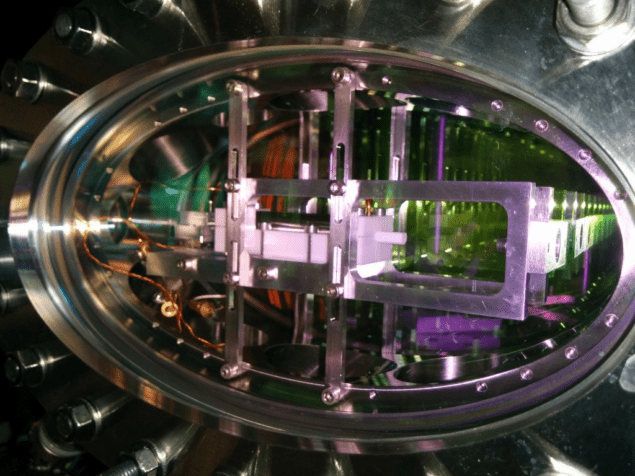Optical conveyor belt moves ultracold atoms into hollow optical fibre

A practical technique that can quickly and efficiently transport ultracold atoms into a hollow fibre has been created by Patrick Windpassinger and colleagues at Johannes Gutenberg University Mainz in Germany. The technique involves allowing the atoms to ride on an “optical conveyor belt” created by two laser beams. Once inside the optical fibre, the atoms could be used in a wide range of applications, including quantum computing and sensing.
One way to do this is to confine a cloud of ultracold atoms within a hollow fibre before firing the appropriate laser light into the fibre. However, getting the atoms into a fibre without heating them up or losing most of them is a big challenge.Over the past few decades, ensembles of ultracold atoms have proved incredibly for applications such as simulating quantum states of matter, measuring tiny forces and storing and processing quantum information. Most applications involve the interaction of laser light with atoms, so physicists are keen to find ways of making this interaction as precise as possible.
Keeping cool
One way of doing this is to let the atoms fall under gravity into a fibre or using a “magnetic funnel”. Another is the optical conveyor belt, which was first demonstrated in 2014 at the University of Tokyo by Hidetoshi Katori and colleagues. A key benefit of this technique, according to Windpassinger and colleagues, is that the atoms can be transported and positioned with great precision. However, doing so without losing lots of atoms or without heating the atoms remain important goals.
Now, Windpassinger and colleagues have built and characterized an optical conveyor system and shown that atoms can be transported in relatively large numbers while keeping them ultracold.
It involves first trapping and cooling of a cloud of rubidium-87 atoms in a magneto-optical trap (MOT). The atoms are initially held about 6 mm from the end of a fibre that is 10 cm long with a hollow core of diameter 60 µm.
Nodes and antinodes
The team then switches on a 1D optical lattice that is created by two counter-propagating laser beams that pass through the centre of the MOT and the fibre core. The lattice comprises nodes and antinodes of laser light that trap atoms at regular intervals.
The frequencies of the lasers are then changed slightly, which causes the nodes and antinodes to move towards and into the fibre at velocities as high as 0.4 m/s. This transports some of the atoms out of the MOT and about 6 mm into the fibre.
The transport process involves first accelerating and then decelerating the atoms, and Windpassinger and colleagues looked at how these processes affect the numbers of atoms that can be moved to the entrance to the fibre. Initially, they found that sharper accelerations (corresponding to shorter transport times) result in greater numbers of atoms being moved. They concluded, however, that this was not related to the transport process itself, but rather to the fact during shorter transport times fewer atoms have the chance to escape the conveyor.
Keeping cool
The team also looked at how acceleration and deceleration affected the temperature of the transported atoms. The atoms begin at a temperature of about 100 µK and the team predicted that this temperature should increase as the atoms are transported towards the tip of the fibre – which was confirmed experimentally. They also showed that by changing the amplitude of the trapping lasers during the transport process, they can nearly eliminate heating. However, this comes at the cost of losing atoms more and therefore a reduction in transport efficiency.READ MORE

Windpassinger and colleagues also looked at transport efficiency and final temperature for atoms that had been moved 6 mm inside the fibre – and found these parameters to be broadly similar to what was measured outside the fibre. For example, the team was able to transport atoms chilled to 70 µK with an efficiency of about 10%, whereas 40% was possible for atoms at 940 µK.
Windpassinger told Physics World that this work marks the end of the development phase of their optical conveyor and the next step for the team is to investigate potential applications of the technology. At the top of his list is to create Rydberg states within the trapped atoms. These states can mediate interactions between photons, creating “molecules of light” that could be useful for storing quantum information. Rydberg states in fibres could also be useful for creating sensors for detecting electromagnetic fields.
The research is described in the New Journal of Physics.
14/9/2018 FROM PHYSICSWORLD.COM
Δεν υπάρχουν σχόλια:
Δημοσίευση σχολίου